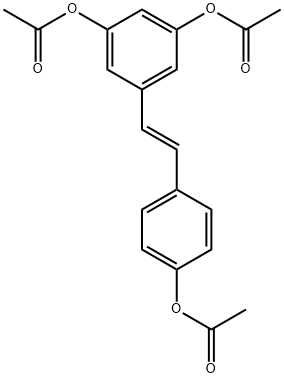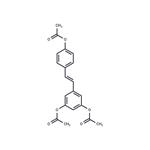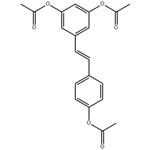Triacetyl resveratrol (CAS 42206-94-0) is a resveratrol prodrug. One method for increasing the half-life of resveratrol?in vivo?is acetylation of the phenolic OH groups. Deacetylation takes place?in vivo?or in intact cells via the action of intracellular esterases releasing active resveratrol.
White crystal or white crystal
trans-Resveratrol Triacetate is the acetylated analogue of Resveratrol (R150000) that is a natural antioxidant and a potential radioprotective agent. trans-Resveratrol Triacetate induces p53 activity and inhibits proliferation in breast and prostate tumor cell lines.
ChEBI: Acetic acid [4-[2-(3,5-diacetyloxyphenyl)ethenyl]phenyl] ester is a stilbenoid.
A cell-permeable triacetate resveratrol prodrug that is easily converted to resveratrol by esterase activity and exhibits similar bioactivity as resveratrol in cell cultures. Cremophor EL is reported to protect the prodrug from fast hydrolysis and resveratrol conversion in mouse serum at 37°C (100% conversion within 20 sec vs. >300 min or T1/2 of 48 min delivered with DMSO or 1:1:8 (v/v/v) EtOH/Cremophor EL/H2O, respectively; [prodrug]t=0 = 100 μM), although the active drug resveratrol is stable for more than 27 h under the same condition without Cremophor EL. When dosed at 10 mg/kg and delivered with 1:1:8 (v/v/v) EtOH/Cremophor EL/H2O intraperitoneally before, but not after, exposure to lethal γ-irradiation (9.75 Gy), the prodrug, but not resveratrol, is shown to greatly prevent irradiation-induced death in mice in vivo (survival rate = 77.4% with 10 mg/kg prodrug vs. ≤28.3% with 10 mg/kg resveratrol, vehicle alone, or no pretreatment at all).
Triacetyl resveratrol displays superior bioavailability to the parent compound, resveratrol. The compound induces p53 activity and inhibits proliferation in breast and prostate tumor cell lines.
After acetylated resveratrol enters the body, it is converted into resveratrol in the body to exert its biological activity. Acetylated Resveratrol Compared to Regular Resveratrol:
1) The stability is enhanced. Since the three active phenolic hydroxyl groups are acetylated, the stability of acetylated resveratrol is significantly improved;
2) The bioavailability is improved, due to prolonging the residence time in the body and increasing the half-life, the bioavailability is better. Acetylated resveratrol can be widely used in food, beverage and health care products.
Triacetylresveratrol significantly down-regulates anti-apoptotic Bcl-2 family protein Mcl-1 and up-regulates pro-apoptotic Bcl-2 family proteins Bim and Puma. Triacetylresveratrol inhibits cell viability, and induces apoptosis of pancreatic cancer cells in a concentration and incubation time-dependent manner.
1) Hsieh?et al.?(2011),?Control of prostate cell growth, DNA damage and repair and gene expression by resveratrol analogues, in vitro; Carcinogenesis,?32?93
2) Hsieh?et al.?(2011),?Regulation of p53 and cell proliferation by resveratrol and it’s derivatives in breast cancer cells: an in silico and biochemical approach to targeting integrin αvβ3; Int. J. Cancer,?129?2732



